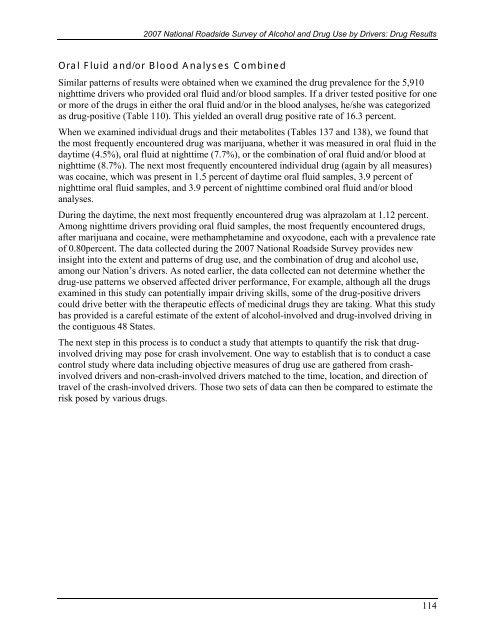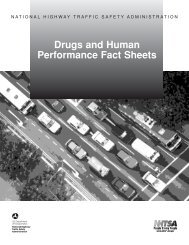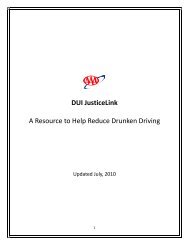2007 National Roadside Survey of Alcohol and Drug Use by Drivers
2007 National Roadside Survey of Alcohol and Drug Use by Drivers
2007 National Roadside Survey of Alcohol and Drug Use by Drivers
Create successful ePaper yourself
Turn your PDF publications into a flip-book with our unique Google optimized e-Paper software.
<strong>2007</strong> <strong>National</strong> <strong>Roadside</strong> <strong>Survey</strong> <strong>of</strong> <strong>Alcohol</strong> <strong>and</strong> <strong>Drug</strong> <strong>Use</strong> <strong>by</strong> <strong>Drivers</strong>: <strong>Drug</strong> ResultsOral Fluid <strong>and</strong>/or Blood Analyses CombinedSimilar patterns <strong>of</strong> results were obtained when we examined the drug prevalence for the 5,910nighttime drivers who provided oral fluid <strong>and</strong>/or blood samples. If a driver tested positive for oneor more <strong>of</strong> the drugs in either the oral fluid <strong>and</strong>/or in the blood analyses, he/she was categorizedas drug-positive (Table 110). This yielded an overall drug positive rate <strong>of</strong> 16.3 percent.When we examined individual drugs <strong>and</strong> their metabolites (Tables 137 <strong>and</strong> 138), we found thatthe most frequently encountered drug was marijuana, whether it was measured in oral fluid in thedaytime (4.5%), oral fluid at nighttime (7.7%), or the combination <strong>of</strong> oral fluid <strong>and</strong>/or blood atnighttime (8.7%). The next most frequently encountered individual drug (again <strong>by</strong> all measures)was cocaine, which was present in 1.5 percent <strong>of</strong> daytime oral fluid samples, 3.9 percent <strong>of</strong>nighttime oral fluid samples, <strong>and</strong> 3.9 percent <strong>of</strong> nighttime combined oral fluid <strong>and</strong>/or bloodanalyses.During the daytime, the next most frequently encountered drug was alprazolam at 1.12 percent.Among nighttime drivers providing oral fluid samples, the most frequently encountered drugs,after marijuana <strong>and</strong> cocaine, were methamphetamine <strong>and</strong> oxycodone, each with a prevalence rate<strong>of</strong> 0.80percent. The data collected during the <strong>2007</strong> <strong>National</strong> <strong>Roadside</strong> <strong>Survey</strong> provides newinsight into the extent <strong>and</strong> patterns <strong>of</strong> drug use, <strong>and</strong> the combination <strong>of</strong> drug <strong>and</strong> alcohol use,among our Nation’s drivers. As noted earlier, the data collected can not determine whether thedrug-use patterns we observed affected driver performance, For example, although all the drugsexamined in this study can potentially impair driving skills, some <strong>of</strong> the drug-positive driverscould drive better with the therapeutic effects <strong>of</strong> medicinal drugs they are taking. What this studyhas provided is a careful estimate <strong>of</strong> the extent <strong>of</strong> alcohol-involved <strong>and</strong> drug-involved driving inthe contiguous 48 States.The next step in this process is to conduct a study that attempts to quantify the risk that druginvolveddriving may pose for crash involvement. One way to establish that is to conduct a casecontrol study where data including objective measures <strong>of</strong> drug use are gathered from crashinvolveddrivers <strong>and</strong> non-crash-involved drivers matched to the time, location, <strong>and</strong> direction <strong>of</strong>travel <strong>of</strong> the crash-involved drivers. Those two sets <strong>of</strong> data can then be compared to estimate therisk posed <strong>by</strong> various drugs.114




